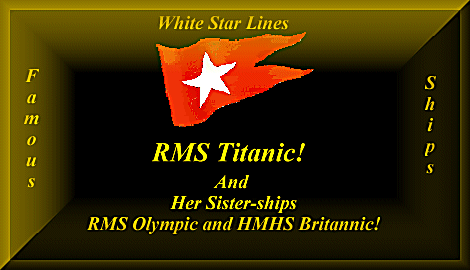|
|
|

|
|
|
The Olympic was launched on the 20th of October 1910, and her maiden voyage from South Hampton to New York, was on the 14th of June 1911, under the command of Captain E.J Smith. The Olympic served Whitestar line ( which later was to become part of the Government forced merger * Cunard-Whitestar line* ) for some 25 years. However during her 25 year service, this was not to be without it's fair share of drama's and fortune's. On the 20th of September 1911, while on a return voyage from New York to South Hampton, the Olympic was rammed by the British Naval cruiser HMS Hawke. The Hawke attempted to pass atsern of the Olympic, and hit her abreast the mainmast, on the starboard side. The Olympic, then returned to Belfast for her repairs, and was out of action for some six weeks. The resulting enquiry into the collision, found the Olympic to be at fault. She was travelling at a greater speed, than required for cruising up the Solent, and had sucked the much smaller Hawke of course. In February 1912, while on yet another return trip from New York to South Hampton, the Olympic broke a propeller blade, and returned to Belfast for repairs. After the loss of her sister-ship the Titanic, the Olympic, was taken out of service, and returned to Harland and Wolff, for extensive modifications. These modifications included -- The double bottom of the hull was extended to the waterline, Full height bulkheads replaced the older much shorteer ones, and more lifeboats was added, to have enough space for all on board. In August 1914, the Olympic was requisitioned by the British Armed Forces as a troopship. In October of 1914, the Olympic tried to tow a wounded ship the HMS Audacious into Loch Foyle, this attept was unsuccessful. September 15th 1915, after an extensive overhaul, which included a comando type paint job, and being fitted with several 6" guns, she resumed her services as a troop carrier. During 1916, she avoided being torpedoed, and sunk by two failed German attempts to sink her, on the third occation, on the 12th of May 1918, a German submarine attempted to sink her, when the Olympic rammed the U - 103, and successfully sank the sub. During her service in the war, the Olympic carried over 200,000 troops, and steamed over 180,000 miles. After the war, the Olympic returned to Harland and Wolff, and was again refurbished for Whitestar line. These new modifications included -- a new paint job, back to the origional colors, oil burning engines, and the passenger accommodations, was re-styled, which now could accommodate 750 1st class, 500 2nd class, and 1,150 3rd class passengers. The Olympic returned to services for the Whitestar line, on her familiar run from South Hampton to New York on the 25th of June 1920. The 22nd of March 1924, the Olympic collided with the Furness line ship St. George. Both ships only suffered minnor damage. On May 10th 1934, she became part of the new Cunard-Whitestar line. On her first voyage under the new flag, while leaving New York, bound for South Hampton, she rammed and sank the Nantucket Lightship, in severe fog. This collision killed 8 people, on the Nantucket. On the 27th of March 1935, the Olympic sailed her last voyage, from South Hampton to New York, and return. After this, she was taken to the ships graveyard for dismantling, and on the 19th of September 1937, she was towed to Inverkeithing for final demolition. |